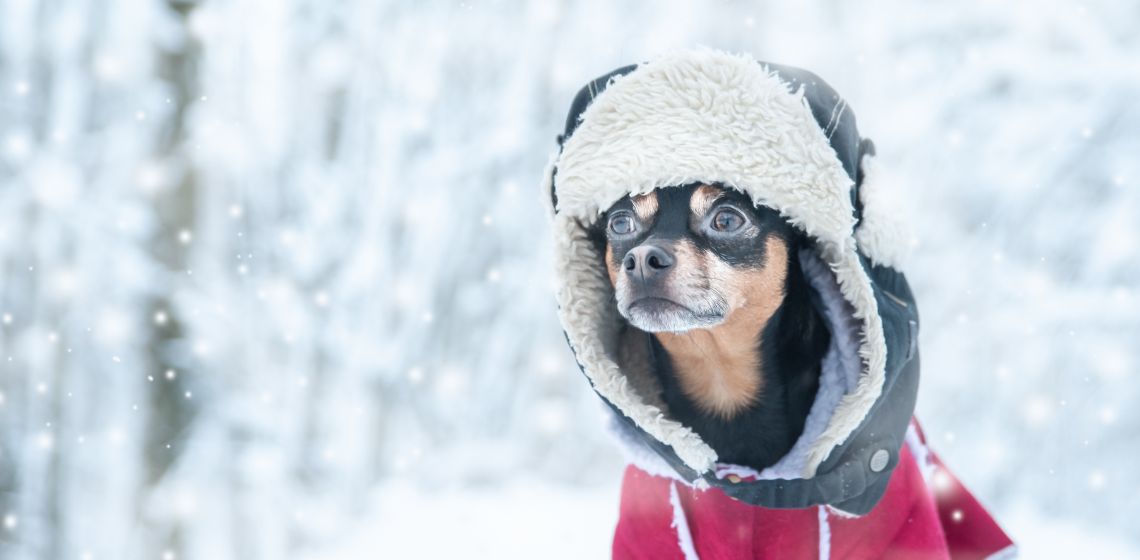Table of Contents
When the weather turns cold, there is a risk of snow and ice storms. Blizzards and ice storms pose several threats to safety. Humans and animals are at risk of hypothermia and frostbite if caught in harsh cold weather temperatures. As a pet owner, it is important that you are prepared to keep not only yourself safe in these conditions, but your dependent pets as well. Below are some things to consider when facing the threat of a winter storm.
Stay Informed
It is imperative to stay up to date with imminent threats of a winter storm. Frequently check weather sources for the most recent weather projections. It is possible that power and internet may be lost during a storm so having a radio handy may be helpful and keep your cell phone battery fully charged. At the first threat of a severe storm, preparation for harsh weather conditions should be initiated.
Have a Plan
Consider evacuating to a safer location if there is a high probability of a severe storm. Do not wait until the last minute to evacuate. Reach out to family and friends outside of the projected storm path to see if housing is available to you and your companion animals. If you need to seek a hotel, ensure that they can accommodate your pets as well.
Avoid unnecessary travel during a storm if possible. If you must travel, ensure that an emergency kit is packed in the event that you become stranded on the road. See below for a list of suggested items to include in your emergency travel kit. Packing cat litter can help provide traction if your car gets stuck in the snow.
Ensure Adequate Food Supply and Medication
Winter storms result in fallen trees and treacherous roadways, making it difficult to leave the home. At the first sign of a possible winter storm, ensure that your pet has all the food necessities needed to last for at least 1-2 weeks. The same should be done with medications your pet relies on. If your pet is prone to anxiety associated with unfamiliar environments or circumstances, reach out to a veterinarian near you well in advance for anxiety medication if beneficial to your companion.
Consider Weather Appropriate Garments
Snow and ice can be harsh conditions for pets to be exposed to. Dogs that will be needing to go outdoors to relieve themselves should have weather appropriate garments. This may include jackets or sweaters for temperature sensitive dogs, as well as protective booties.
Ensure Proper Shelter
For animals living outdoors, it is imperative to prepare well in advance appropriate shelter to offer protection from a winter storm. If possible, outdoor animals should be brought indoors to minimize the risk of hypothermia or harm secondary to the weather conditions. For animals who are unable to be brought indoors, ensure that there is a sturdy structure that can block wind and keep out snow and ice. Additionally, the interior of the structure should be designed to keep body heat in. Access must be provided to un-frozen drinking water.
Even indoor animals and people are at risk of hypothermia if electricity is lost during a winter storm. Gather blankets and fire logs if appropriate.
Collect Pet Documents and Items
In the event of a storm, the more prepared you are, the better. Collect all important paperwork that may be beneficial to have if your pet needs care during the storm. This should include vaccination history (especially proof of an up-to-date rabies vaccine), recent blood work, and microchip information.
Ensure that your pet is easily identifiable through a name tag and collar if possible.
Gather Emergency Supplies
In the event of a storm, or any other natural disaster, it is imperative that basic supplies are readily available. Below are recommended emergency supplies to have on hand.
- Blankets
- Batteries
- Flashlights
- Several gallons of bottled water
- Non-perishable food Items
- Shovel
- First Aid Kit
- Leash and harness/collar
- Pet carrier
Be Aware of Chemical Threats
Often in preparation for freezing temperatures, salt will be laid on roads. If more than a little salt is consumed by animals, it can lead to excessive amounts of salt called hypernatremia. Hypernatremia in animals can cause vomiting, seizures, and tremors. Additionally, chemicals used to melt ice can be irritating to the paws of companion animals. It is recommended to rinse off and wipe clean paws and the undercarriage after being outdoors on treated surfaces. Ensure that your pet is thoroughly dried afterwards.
Antifreeze is a product used to help regulate engine temperatures and helps lower the freezing threshold of fluids used in automobiles. The product has a sweet smell and can be enticing to pets. Be careful if using this product around your companions as it can cause acute kidney failure even if a small amount is consumed. Safer alternatives are available that are made from propylene glycol instead of harmful ethylene glycol.
Summary
Preparedness cannot be underestimated in the face of an emergency like a winter storm. Having supplies and a plan available will help ensure your safety, as well as the safety of your beloved companions. Stay alert and stay informed of any changes to the weather that may have an impact on your household.

Dr. Marti Dudley attended veterinary school at Ross University in St. Kitts, and completed her clinical year at Virginia-Maryland Regional College of Veterinary Medicine. Since graduating in 2014, Marti has worked as an associate veterinarian at a small animal practice in her hometown of Williamsburg, Virginia. She enjoys providing personalized care to patients and emphasizes the importance of preventative medicine. Marti shares her home with her husband and children, along with a menagerie of pets. In her spare time, she enjoys camping with her family and relaxing with her pets.








